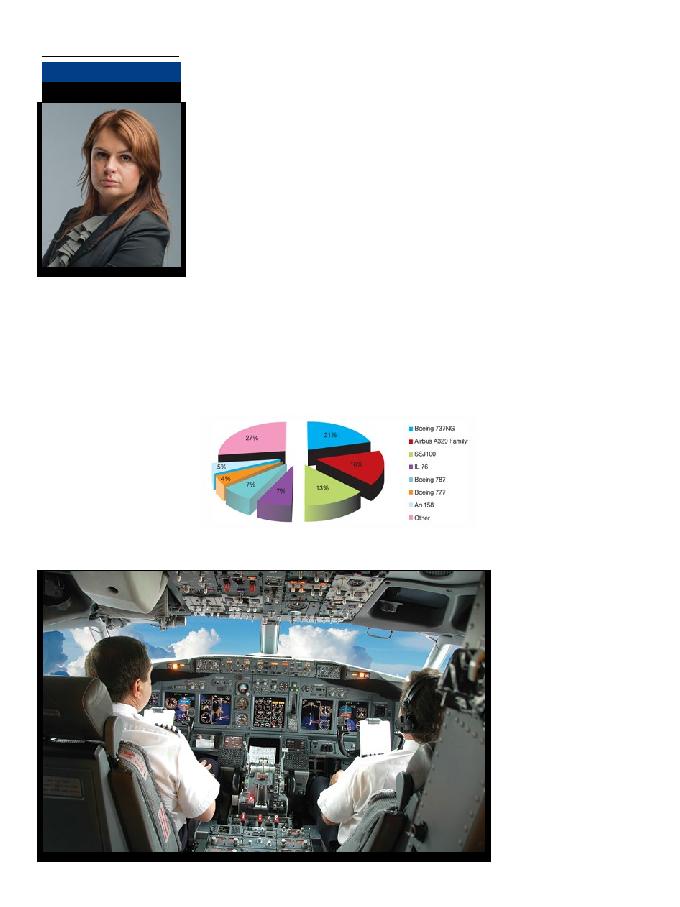
16
GA
/ Vol. 5 / No.4 / APRIL 2013
by Skaiste Knyzaite
CEO of AviationCV.com - Source: Ascend
Airline News
Recently the Russian Ministry of
Transport has prepared an amendment
allowing the employment of foreign
pilots by the Russian carriers. Under
the initiative the Ministry suggests
to open a 200 Pilot-in-Command
(PIC) quota for foreigners, which
would be effective for five years.
According to the officials, currently
the Russian market lacks only the
aforementioned number of PICs with
zero-rate deficit of First Officers
(FO). However, high wages, which
are up to 30% higher than in Europe,
along with the competition among
local carriers seeking for experienced
candidates, may serve as evidence that
the suggested quota is still insufficient
to ensure the successful development
of the air transportation in Russia.
According to industry experts,
currently Russia requires approx.
1000-2000 new pilots each year.
Unfortunately, national aviation
training institutes are capable of
preparing only about 700-900 young
specialists. Considering the fact that
only relatively recently that number
was raised from 500 pilots per year, it
comes as no surprise that the Russian
aviation market is faced with the serious
shortage of experienced specialists.
Pilot shortage remains a topical
issue in various regions, particularly
in Asia, where some companies are
already forced to moderate their
expansion plans and keep some of
the fleet on the ground as there is
no one to operate it. The situation
in Russia has not yet reached such
extremity, but many local carrier
already stress that the issue of limited
pilot offer in the market is alarming.
The ever-growing deficit forces
Russian air companies to entice
experienced pilots from each other
since the market cannot prepare the
required amount of PICs and no
foreigners are currently permitted to fill
in the vacant positions. This eventually
results in pay raise. In Europe the
average salary of a Boeing 737NG
PIC is $7-8 thousand. Meanwhile, in
Russia the pay is up to 30% higher
approx. $10-12 thousand per month.
The statistics show that on average
approx. 5% of pilots worldwide
(including Russia) retire each year. The
preparation of a new PIC takes about
5 to 7 years. Considering the moderate
numbers of aviation schools' graduates
during the past few years, the upcoming
generation of PICs will suffice to
cover the current fleet. However,
the number is definitely too low to
support the extensive fleet expansion.
During the upcoming 5 years
Russian carriers will receive approx.
500 new aircraft the majority of
which are Western-made. This does
not include the transactions of pre-
owned aircraft, dozens of which are
being bought or leased each year.
Depending on a particular aircraft
type, every new aircraft in a carrier's
fleet may require on average of 16
pilots, or 4 full crews. This suggests
that the real demand for PICs in the
Deliveries of
new aircraft
to Russian air
companies and
air forces during
2013-2018
upcoming 5 years will exceed 2000.
The roots of the current situation
in the Russian market can be traced
back to the Soviet times, when the
region's air companies used to operate
Soviet-made aircraft, and there was
no need for the development and
integration into the global market.
Several decades ago many Asian-
Pacific countries were also closed to
foreign pilots. However, along with
the extensive development of air
transportation in the region, the demand
for experienced pilots rocketed.
Due to limited local resources Asian
countries didn't have the capabilities
to prepare the required amount of
specialists on time. As a result some
of the countries opened their markets
to foreign pilots including China
and Vietnam which had traditionally
been perceived as being even more
conservative countries than Russia.
The industry practice has shown
that welcoming foreign pilots usually
results in positive consequences, since
many specialists arrive from Europe
and the USA. Foreign pilots can share
their experience and promote higher
proficiency of Aviation English among
local crew-members thus contributing
to higher flight safety both in the
country and across the region.
According to experts, today
approx. 5% of experienced pilots
have no jobs, which corresponds
to about 12 000 specialists. Some
of these pilots are from Europe and
the USA where several large and
many small carriers have recently
gone bankrupt or restructured their
businesses. By opening the Russian
market to foreign pilots the country
would definitely attract the attention
of specialists from around the world.
Meanwhile, some experts are
concerned that foreign pilots might
inflict additional risks related to
cultural differences, miscommunication
and other human factors. However,
previous success in opening markets
to foreign nationals has proven that
multi-national crews do not pose
any additional risks. Aviation, unlike
many other industries, operates under
universal rules and principles.
The allowance of foreign pilots will
be `the gulp of fresh air' for Russian
air companies. However, we believe
that 200 pilot quota is not enough to
support the ever-growing demand for
experienced specialists. Already today
we receive inquiries from pilots from
the CIS and Europe who are ready
to move to Russia and work for local
carriers. Should the market be opened
for foreigners (both PICs and FOs) it
will be a huge help to Russian carriers
in implementing their strategic plans
and optimizing costs. Moreover, an
increased competition on the market
would restrain the growing rates of
salaries. Air companies would also find
it easier to adapt their crews to seasonal
changes, when additional pilots are
required just for several months. ·
Deliveries of new aircraft to Russian air companies and
air forces during 2013-2018. Source: Ascend

